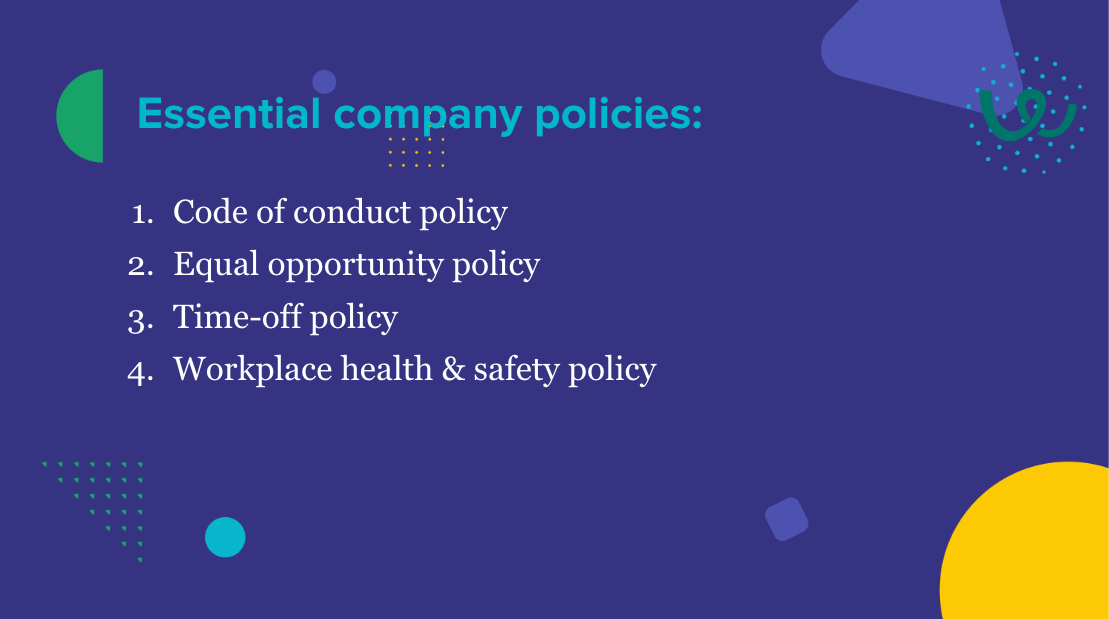18 policies every organization should have (+templates)
Keeping your business structured and compliant, policies provide essential guidance and clarity for decision-making and behavior within your organization. They ensure consistency, legal compliance, and effective risk management, safeguarding your assets and reputation. Here’s a helpful list for you.

Bringing the human factor to the forefront, policies foster employee engagement, satisfaction, and productivity by promoting transparency and fairness.
Reflecting your company’s values and culture, policies contribute to a cohesive work environment, ultimately driving the success and sustainability of your business.
From smaller companies to large organizations, policies are vital for their existence, serving as a shield against any threats to your organization.
As your company evolves, so should your policies. It’s important to seek legal approval before implementing new policies due to the rapidly changing landscape.
Here’s a list of the top 18 company policies your organization should have, and guess what? We have ready-to-use templates for each of them linked to their titles.
Contents
Company policies you need to have

1. Code of conduct policy
The Employee Code of Conduct policy is among the policies every organization should have. It sets forth the standards of behavior expected from employees in their interactions with colleagues, supervisors, and the organization as a whole. It underscores the importance of transparent communication, professionalism, mutual respect, and compliance with legal requirements. Additionally, it delineates the consequences for any breaches of these standards.
A code of conduct policy delineates the appropriate conduct expected of employees within the workplace, encompassing their interactions with colleagues, supervisors, and the overarching organization. This template for an Employee Code of Conduct Company Policy can be customized to suit your company’s specific requirements and serves as a foundational document for establishing your employment guidelines. This policy may alternatively be referred to as a Conduct in the Workplace Policy.
2. Equal employment opportunity policy
The Equal Opportunity Policy emphasizes the importance of fairness and diversity within the workplace, ensuring that all aspects of employment remain free from discrimination based on protected characteristics. This policy promotes an environment where the rights of every individual are respected and valued, from the hiring process to termination.
Key components of this policy include clear definitions of protected attributes such as age, gender, ethnicity, and religion, guidelines to ensure fairness in all stages of employment, and procedures for reporting violations with outlined disciplinary actions for non-compliance.
3. Workplace health and safety policy
The Workplace Health and Safety policy underscores the company’s dedication to fostering a safe and hazard-free environment for its employees. It comprehensively outlines preventive measures, emergency protocols, and supplementary actions aimed at promoting health and safety standards. This policy highlights the significance of adhering to established guidelines and procedures to mitigate risks effectively.
Key elements encompass preventive action guidelines, which detail risk assessments, job hazard analysis, and strategies to prevent workplace-related injuries or illnesses. Additionally, it includes emergency management provisions addressing plans for responding to sudden catastrophes such as fires, floods, and other emergencies. Furthermore, the policy emphasizes additional measures such as regularly updating the policy in alignment with legislative changes, analyzing past incidents for improvement, and establishing clear procedures for accident reporting.
4. Leave and time off policy
The Paid Time Off (PTO) Policy outlines the provision of paid leave offered to employees on an annual basis, covering vacation time that can be utilized at the employee’s discretion. It’s essential and one of the policies every organization should have.
It delineates the accrual process, usage guidelines, and distinguishes PTO from other forms of leave.
Essential components to include in this policy involve defining and differentiating PTO from other types of leave, specifying the accrual process, including the amount of PTO offered to various categories of employees. Additionally, it should detail procedures for requesting PTO and provide guidelines on its usage throughout the year.
5. Data protection and privacy policy
The Data Protection Policy underscores the company’s dedication to handling information with meticulous care and confidentiality. It emphasizes transparency in the collection, storage, and handling of data while upholding individual rights.
This policy extends to employees, contractors, partners, and other entities requiring occasional access to data. Key elements to include in this data protection policy involve defining the types of data collected and specifying the parties covered by the policy.
Additionally, it entails establishing rules for collecting, storing, and handling data to ensure accuracy, security, and legal compliance. Furthermore, the policy outlines procedures for reporting data breaches and misuse, along with delineating the company’s obligations towards data owners.
6. Social media policies
The Social Media Policy offers comprehensive guidelines for employees regarding their use of social media platforms, whether for personal or professional purposes on behalf of the company. It underscores the importance of responsible utilization, maintaining productivity, and safeguarding the company’s image and confidentiality.
Additionally, the policy outlines potential disciplinary actions for any violations. Key components of this policy include guidelines for using personal social media during work hours to ensure it doesn’t impede productivity.
Moreover, it provides clear instructions for employees representing the company on social media platforms, emphasizing the values of respect, accuracy, and responsibility. Furthermore, disciplinary consequences for policy violations, including the possibility of termination, are clearly outlined within the policy.
7. Remote work policy
The Remote Work Policy sets forth clear guidelines for employees engaged in work outside the traditional office environment. It defines remote work arrangements, providing clarity on both permanent and temporary setups. Additionally, it offers comprehensive guidance to ensure the effectiveness of remote work, covering aspects such as workspace setup and communication practices.
The policy underscores the importance of compliance with company policies, emphasizing the adherence to established standards even in remote work settings. Furthermore, it details provisions regarding equipment provisions, compensation adjustments, and ensures alignment with other company policies for remote employees.
8. Expense reimbursement policy
The Employee Expense Policy provides a structured framework for reimbursing employees for work-related expenditures. It categorizes expenses into two main groups: those directly covered by the company and those eligible for reimbursement to employees.
Emphasizing the importance of thorough documentation and adherence to approval processes, the policy aims to streamline expense management. It also offers clear definitions of reimbursable and non-reimbursable expenses, ensuring clarity for employees.
Key components of this policy include defining work-related expenses and delineating between company-paid and reimbursable expenses. Additionally, it provides detailed guidelines on what qualifies as reimbursable expenses and outlines the necessary documentation.
Moreover, the policy establishes procedures for submitting reimbursement claims, including timelines and the approval process, to ensure transparency and efficiency in expense reimbursement.
9. Conflict of interest policy
One of the policies that every organization should have is, also, the Conflict of Interest Company Policy. It is designed to mitigate situations where an employee’s personal interests could potentially conflict with those of the company. It places a strong emphasis on fostering mutual trust and transparency within the organization.
By providing clear definitions and examples of potential conflicts of interest, the policy aims to raise awareness among employees. Additionally, it outlines procedures for reporting and resolving identified or suspected conflicts, ensuring prompt and appropriate action is taken to address any conflicts that arise.
Moreover, the policy specifies disciplinary consequences for employees who conceal conflicts of interest or fail to resolve them in a timely manner, underscoring the importance of compliance and accountability within the company.
10. Whistleblower policy
The corporate whistleblower policy serves as a vital mechanism for employees to report any instances of unethical or illegal behavior within the organization without fear of retaliation.
Its primary goal is to foster a culture of transparency and accountability within the company.
A well-crafted whistleblower policy is crucial for promoting ethical practices and ensuring the integrity of the organization. HR professionals can utilize this template to tailor a policy that aligns with the specific needs and values of their organization, providing employees with a safe and confidential reporting avenue.
By implementing such a policy, HR demonstrates the company’s commitment to maintaining a safe and ethical workplace for all employees.
11. Performance management policy
Performance Management is a structured process aimed at enhancing a company’s effectiveness through the improvement of its employees’ performance. This policy delineates the organization’s approach to managing employee performance, encompassing objective setting, performance reviews, feedback mechanisms, and development plans.
A comprehensive Performance Management Policy should include clear definitions of performance management and delineate the respective responsibilities of both employers and employees throughout the process.
It should also outline the procedures for setting objectives and conducting performance reviews, as well as the steps the organization will take to address any performance issues that may arise. Additionally, the policy should specify the potential consequences for unsatisfactory performance.
This Performance Management Policy template is provided as a foundational resource that can be customized to suit the specific needs and requirements of your company. It serves as a starting point for establishing comprehensive employment policies tailored to your organization’s unique context.
12. Email use policy
The Email Usage Policy serves as a guiding framework for employees utilizing corporate email addresses, establishing clear guidelines regarding their appropriate and inappropriate usage. It underscores the importance of adhering to security measures and maintaining professionalism in all email communications.
Additionally, the policy addresses limitations on personal use, outlines specifications for email signatures, and delineates potential disciplinary actions for violations.
A comprehensive corporate email usage policy should include distinct criteria distinguishing appropriate from inappropriate email use, encompassing security measures such as password requirements and strategies for identifying phishing attempts. Moreover, it should provide guidance on crafting professional email signatures and specify the consequences of policy breaches.
13. Harassment and discrimination policy
The Anti-Discrimination Policy is paramount in establishing a safe and inclusive workplace environment, aiming to prevent discrimination based on protected characteristics. It meticulously outlines behaviors deemed discriminatory and specifies the corresponding actions to be taken, thereby upholding principles of fairness and equality for all employees.
This policy should incorporate comprehensive definitions of discrimination along with a delineation of protected characteristics, encompassing factors like age, gender, ethnicity, and sexual orientation. Furthermore, it should provide explicit examples of discriminatory behaviors, accompanied by the prescribed consequences for such actions.
Additionally, clear procedures should be established for reporting, investigating, and addressing discrimination complaints in a timely and effective manner.
14. Recruitment and selection policy
The Employee Recruitment and Selection Policy serves as a comprehensive guide to the procedures involved in attracting and selecting external job candidates. It underscores the importance of conducting a well-structured and discrimination-free hiring process to ensure fairness and equality. The policy offers detailed guidelines for various aspects of recruitment and selection, including job postings, selection stages, feedback mechanisms, and potential offer revocations.
Key components to include in this Employee Recruitment and Selection Policy involve providing an overview of the recruitment and selection process, from identifying the need for an opening to extending an official job offer.
Additionally, it should outline specific guidelines for job postings, covering internal postings, creation of job descriptions, and ensuring clarity and consistency in job advertisements.
Furthermore, the policy should detail the standard selection stages, such as resume screening, phone screening, and interviews, while also allowing flexibility to adapt or modify stages as necessary to meet the organization’s needs and objectives.
15. Travel policy
The company travel policy serves as a comprehensive guide for business-related travel, detailing reimbursable expenses and guidelines for employees. It encompasses various aspects such as transportation, accommodation, legal/medical expenses, and daily allowances.
Employees are encouraged to exercise discretion and ensure timely submission of expenses for reimbursement. Key components to include in the policy are guidelines on transportation methods and their reimbursement, provisions for accommodation including specified hotel standards, and instructions for managing meal expenses and client meetings during trips.
16. Drug and alcohol policy
The drug and alcohol policy establishes guidelines for the acceptable use and misuse of drugs and alcohol in the workplace, aiming to maintain a safe and productive work environment. It sets clear boundaries regarding the consumption and possession of these substances while also providing support mechanisms for employees facing substance misuse issues.
17. Intellectual property policy
An Intellectual Property (IP) Policy is a framework that governs the creation, protection, and use of intellectual property assets within an organization. It outlines the rights and responsibilities of employees regarding the development, ownership, and utilization of intellectual property, including inventions, patents, trademarks, copyrights, and trade secrets.
The policy serves to safeguard the organization’s intellectual assets, promote innovation, and ensure compliance with legal requirements and ethical standards.
Key components that should be included in an Intellectual Property Policy typically encompass provisions for defining the types of intellectual property covered, establishing procedures for disclosing and protecting intellectual property, outlining ownership rights and assignment agreements, specifying confidentiality and non-disclosure obligations, and addressing issues related to licensing, infringement, and enforcement.
18. Grievance handling policy
A Grievance Procedure Policy outlines the process by which employees can express their complaints or grievances in a constructive manner. The policy emphasizes the importance of supervisors and senior management being aware of issues that affect employees’ work and promptly addressing them to prevent conflicts.
Additionally, it promotes open communication and encourages employees to voice their grievances to foster a supportive and pleasant workplace environment.
The employee handbook
Until now, we’ve had the opportunity to explore the most important policies of an organization. However, we felt that this guide would be incomplete without addressing the most crucial asset of the HR department: the employee handbook.
The Employee Handbook serves as an essential resource for new employees during the onboarding process, offering valuable insights beyond mere policies and procedures.
It not only acquaints them with the company’s values, vision, and mission but also provides a comprehensive overview of the organization’s history, product or service offerings, and customer base.
Additionally, the handbook outlines the structure of various teams within the company, providing new hires with a clear understanding of the organizational hierarchy and how they fit into the broader picture.
For HR professionals, the Employee Handbook serves as a centralized repository of essential information that new hires can refer to as they navigate their roles and responsibilities within the organization.
Moreover, the handbook serves as a guide for HR teams, helping them address frequently asked questions related to HR policies and procedures, as well as IT-related queries.
By incorporating details about the HR team and their roles, the handbook facilitates smoother communication channels between employees and HR personnel, fostering a supportive and collaborative work environment.
Let’s complete this article with a disclaimer:
All these policy templates you can find above are meant to provide general guidelines and should be used as a reference. They may not take into account all relevant local, state or federal laws and they are not legal documents. Neither the author nor Workable will assume any legal liability that may arise from the use of these policies. We highly advise you to contact your legal counsel before taking any action.
Frequently asked questions
- Why are company policies important?
- Company policies lay the foundation for a productive and harmonious work environment by setting clear expectations and guidelines for behavior, ensuring fairness, and safeguarding against legal risks. They reflect the company's values and culture, directly influencing employee engagement, satisfaction, and overall productivity.
- What key policies should every organization have?
- Essential policies include Code of Conduct, Equal Employment Opportunity, Workplace Health and Safety, Data Protection and Privacy, and a Grievance Handling Policy. These cover the crucial aspects of employee behavior, safety, privacy, and conflict resolution, crucial for a well-functioning organization.
- How often should policies be updated?
- Due to the rapidly changing legal and social landscape, policies should be reviewed and updated regularly, at least annually, or whenever significant changes in the law or the organization occur. This ensures that policies remain relevant and effective in protecting both the organization and its employees.
- Can I customize the provided policy templates?
- Yes, the provided policy templates are designed to be customized to fit the unique needs and culture of your organization. They serve as a starting point, enabling you to develop comprehensive and specific guidelines that align with your company's values and legal requirements.
- What is the significance of a whistleblower policy?
- A whistleblower policy is crucial for maintaining transparency and accountability within an organization. It provides a safe and confidential avenue for employees to report unethical or illegal activities, ensuring that such issues can be addressed promptly and without fear of retaliation.




